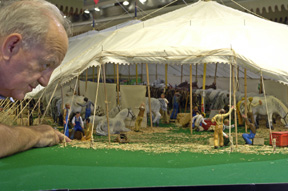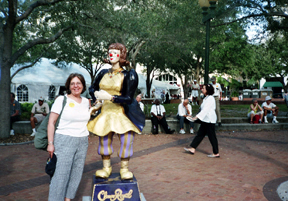 Laurie Spiegel with one of the many clowns located in downtown Sarasota. Photo: Joan Hirsh |
By
LAURIE SPIEGEL
ART TIMES April 2007
I’m fussy. I
like my coffee roasted on the premises, my music live, art museums to
have world class artists like Rubens, Titian and El Greco, restaurants
and shops to be locally owned and the Nutcracker to be Balanchine. Would I find these things in Sarasota Florida? Absolutely,
and more.
Coming
from New York in January my first priority was warm weather, a beautiful
beach, and the sound of the waves. The west coast of Florida is generally
known for beaches with shells but in Sarasota there is also the Siesta
Key beach, judged by the Woods Hole Oceanographic Institution to have
the finest, whitest sands in the world. Where there are good beaches there
are always plenty of lovely resorts. We were happy at the Lido Beach Resort
within walking distance of St. Armand’s circle, known for restaurants
and shopping. We had a large studio with a king sized bed, a sitting area
and a kitchen, all overlooking the gulf. If you want to splurge there is also the
Ritz-Carlton with a spa, a golf club, and a beach club that makes special
cocktails to match the sunset. Both resorts have fine dining restaurants
that I would recommend.
Sarasota prides itself on being the cultural coast of Florida. For the
Performing Arts highlights include the Sarasota Opera, the Sarasota Ballet,
the Florida West Coast Symphony, The Asolo Theater Company, Jazz Club
of Sarasota, the Sarasota Film Festival in April and world famous performers
stopping at the Van Wezel Performing Hall. There is also the magnificent
newly renovated historic 18th century Venetian Asolo Theater,
home of both local and traveling artists. Many performances are done on a repertory
schedule so whether you are in town for one week or the entire season,
there is a great variety to choose from.
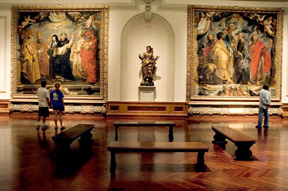 Rubens
Gallery, The John and Mable Ringling Museum of Art. Photo: Ringling
Museum Rubens
Gallery, The John and Mable Ringling Museum of Art. Photo: Ringling
Museum |
Many people associate Sarasota with the circus. That is because in 1927 John Ringling chose Sarasota as the winter home for the Ringling Bros. and Barnum & Bailey circus. While the circus was the initial source of his wealth, Ringling then invested in railroads, oil, and real estate making him one of the country’s twenty wealthiest people by the 1920s. John and his wife Mabel also chose Sarasota for their home Cà d’Zan, and for the John and Mabel Museum of Art to house their art collection. While he envisioned Sarasota as a cultural mecca, attractive to wealthy people from the north, he always intended the art collection to be available to the public. Upon his death in 1936, John left the Museum of Art, the Venetian mansion Cà d’Zan and 66 acres to the people of Florida. Most people would agree it is the Art Museum and its collection that is the greatest legacy. John and Mabel started collecting art when they traveled to Europe to audition new circus acts. They commissioned the architect John Phillips to design the grand Italianate building. Ringling was a showman, so he planned that in each of the 21 galleries in the museum, the walls,
|
|
architectural
detail and occasional furniture would be designed in keeping with the
period of the art displayed there. For example, the gallery housing the
Italian Baroque collection has red walls with the same pattern as seen
in one of the portraits in the gallery. The collection extends from ancient
Cypriot pottery to twentieth century American constructions with lots
of paintings between. The collection is best known for its old masters
including Cranach, Rubens, Poussin, Hals, Van Dyck, and Guercino.
Also
on the Ringling Campus, in the Tibbals Learning Center is the largest
miniature circus in the world. Howard Tibbals, a successful businessman
from Tennessee, spent 50 years researching and recreating the circus of
1938 complete with tents, wagons, animals and 1500 performers and circus
workers. Trust me, words do not do this exhibit justice; you have to see
it to believe it!
Many of the buildings on the Ringling campus including the museum and Ca d’Zan have been recently renovated. Cà d’Zan had fallen into such disrepair that it was used as the decrepit home of Miss Havisham in the 1996 remake of Dicken’s Great Expectations. After 6 years and $15 million, the 41-room mansion has been restored to its original 1926 grandeur. During the Ringling’s travels to Europe they fell in love with Venice and decided to design their dream house on Sarasota Bay after the Doge’s Palace on the GrandCanal, complete
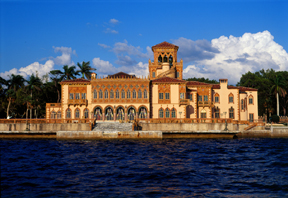 Cà d'Zan, former home of John and Mable Ringling now fully restored. Photo: Cà d'Zan |
with a marble terrace and dock. The mansion reflects the owner’s familiarity with grand houses in America and Europe as many design elements were derived directly from such diverse sources as the Hotel Danieli in Venice Italy and the grand houses in Newport Rhode Island. Just like the circus it is hard to take it all in at once. There are elaborately decorated terra cotta facades, stained glass skylights and doors, marble floors, carved wooden ceilings, Spanish tiles, bronze door surrounds, crystal chandeliers, 17th century tapestries, not to mention furnishings, paintings, and beautifully restored fabrics. It seemed that everything in the house had to be restored. In fact one of the docents guiding us through the mansion is also a lace historian and personally restored some of the lace on Mabel’s bed.
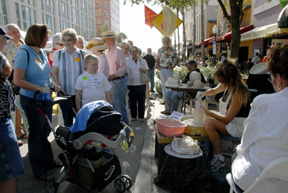 Pottery
Demonstration during Arts Day 2007. Pottery
Demonstration during Arts Day 2007. Photo: Allen Cohen |
Downtown
in the streets and in performance venues such as the Opera House, three
stages in the Florida Studio Theater, and the Golden Apple Theater. There
were 12 stages in all featuring 1000 performers ranging from students
to local independent musicians, to the Sarasota Pops, Sarasota Opera Company
and Sarasota Ballet performing excerpts from “The Nutcracker”. 100 visual
artists were represented in booths and in local galleries; there was also
opportunity to experience sculpting, glass blowing and painting and to
interact with local artists. All the local Arts and Cultural Organizations
had booths to showcase their individual events.
Want
to learn more? I don’t just mean about Sarasota — I mean about everything.
There are plenty of rich venues for lifelong learning in this area.
Longboat Key Center for the Arts has offered classes primarily in the
visual arts and crafts for the last fifty years.
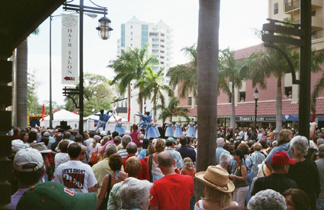 Arts Day 2007 performance by Sarasota Ballet Company Photo: Laurie Spiegel |
The
Ringling Museum now under the governance of Florida State University recently
introduced its Cultural Institute offering university level two-day seminars
on a spectrum of subjects ranging from “The Circus as Community” to “American
Painting”. They also have individual lectures. The University of South
Florida has an Academy for Lifelong Learning with offerings as varied
as Landmark Decisions of the Supreme Court and Beginning Digital Photography.
The Ringling School of Art and Design has both studio and lecture courses,
and for those who are adventuresome enough to start learning a brand new
skill there is beginning Strings for the young at heart at the Florida
West Coast Symphony.
I
left Sarasota wishing I had had more time for everything, from sitting
in the sun and a leisurely massage at the Ritz-Carlton spa to visiting
more galleries, eating at locally owned restaurants, and attending performances
of local artists. I guess that is a good measure of how much you like
a place, when you leave with a list of things to do when you go back.
(Laurie
Spiegel, a worldwide traveler, lives in New York City.)

